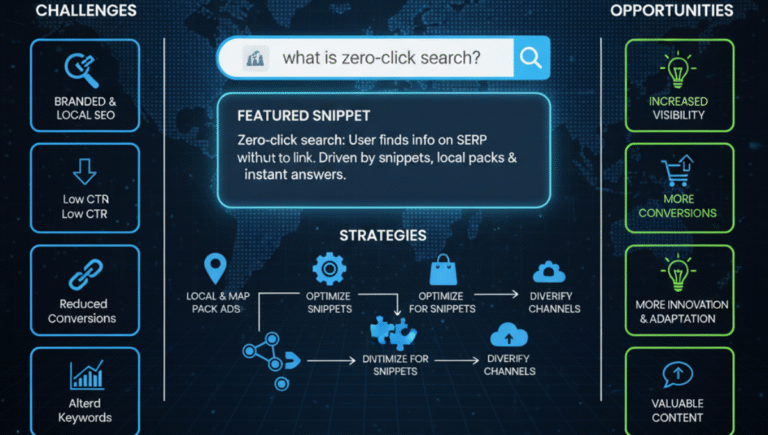In the ever-evolving landscape of digital search, one trend has increasingly captured the attention of marketers and advertisers alike: the rise of zero-click searches. While these searches may seem like a setback for traditional pay-per-click (PPC) advertising, savvy marketers can adapt and thrive. This article explores what zero-click searches are, why they matter, and the most effective strategies to maintain—and even boost—your PPC profitability in this new era.
Understanding Zero-Click Search: What Is It and Why Is It Growing?
Zero-click search occurs when users find the information they need directly on the search results page (SERP), eliminating the need to click on any links. Features like featured snippets, answer boxes, local packs, and rich snippets are designed to deliver quick answers, making user experience seamless but posing challenges for advertisers relying on clicks.
Why Is Zero-Click Search Increasing?
Several factors contribute to the growth of zero-click searches:
- Enhanced SERP Features: Google continuously introduces features like featured snippets, knowledge panels, and local packs to provide instant answers.
- Mobile-First Indexing: With more searches happening on mobile devices, Google prioritizes quick, digestible information.
- Voice Search: Voice assistants often provide direct answers, reducing click-through rates.
- User Intent Shift: Many users seek quick answers, prompting Google to deliver immediate results within the SERP.
While zero-click results improve user experience, they pose a challenge for PPC campaigns that rely solely on clicks for conversions and revenue.
The Impact of Zero-Click Search on PPC Campaigns
The rise of zero-click searches means fewer opportunities for paid ads to be clicked, especially for informational queries. This trend can lead to:
- Reduced Click-Through Rates (CTR): Fewer users are clicking ads when they get answers directly on the SERP.
- Lower Conversion Opportunities: With fewer clicks, there’s a decline in potential conversions.
- Altered Keyword Strategies: Traditional keywords may become less effective if they primarily lead to non-clicked answers.
However, understanding this shift also opens doors to new opportunities and strategies to maintain profitability.
Strategies for Maintaining PPC Profitability Amid Zero-Click Searches
1. Focus on Branded and Navigational Keywords
While informational queries are increasingly answered within SERP features, branded and navigational keywords often still lead to clicks. Invest in campaigns that target your brand name, product names, and direct navigation terms. These keywords tend to have higher CTRs and conversion rates.
2. Leverage Local and Map Pack Ads
Local packs and map features are prominent in searches related to nearby services or products. Ensure your Google My Business (GMB) profile is optimized, and run local PPC campaigns to appear in these sections. This placement can significantly boost visibility and foot traffic.
3. Optimize for Featured Snippets and Rich Results
While you can’t directly pay for featured snippets, you can optimize your content to be more likely to be featured. Use structured data, clear headings, and concise answers to increase your chances of appearing in these coveted spots, enhancing brand visibility.
4. Diversify Advertising Channels
Relying solely on Google Search can be risky in the zero-click era. Expand your advertising efforts to include:
- Social media advertising (Facebook, Instagram, LinkedIn)
- Programmatic display ads
- Video marketing (YouTube ads)
- Email marketing campaigns
Diversification spreads risk and taps into audiences that may not be reachable via organic search.
5. Use Remarketing and Audience Targeting
Implement remarketing campaigns to re-engage users who have visited your site but didn’t convert. Audience targeting allows you to serve personalized ads based on user behavior, increasing the likelihood of conversions despite fewer organic clicks.
6. Invest in Conversion Rate Optimization (CRO)
Since clicks may decline, maximizing the value of each visitor becomes critical. Optimize landing pages, streamline user journeys, and enhance calls-to-action (CTAs) to convert more visitors when they do click.
7. Develop Content That Complements Paid Campaigns
Create content that addresses user intent beyond what SERP features provide. For example, detailed blog posts, videos, and FAQs can provide value and encourage sharing, brand awareness, and indirect conversions.
8. Monitor and Adapt with Data Analytics
Stay agile by continuously analyzing campaign data. Track metrics like CTR, conversion rate, and cost-per-acquisition (CPA). Use insights to refine keywords, ad copy, and targeting to optimize ROI.
Embracing Innovation: The Future of PPC in a Zero-Click World
The zero-click trend is unlikely to reverse, but it encourages innovation in digital marketing. Marketers who adapt by integrating traditional PPC with holistic digital strategies will be better positioned to succeed.
Key takeaways include:
- Prioritize brand visibility and local advertising.
- Optimize content for SERP features.
- Diversify marketing channels.
- Focus on user engagement and conversion optimization.
By embracing these strategies, you can navigate the zero-click landscape confidently and maintain—or even enhance—your PPC profitability.
Conclusion
Zero-click searches represent a significant shift in how users interact with search engines, but they are not the end of PPC advertising. Instead, they challenge marketers to rethink their strategies, focusing on brand strength, local presence, and multi-channel marketing. Through targeted efforts, optimization, and innovation, you can continue to reach your audience effectively and sustain profitable PPC campaigns in this new digital era.
